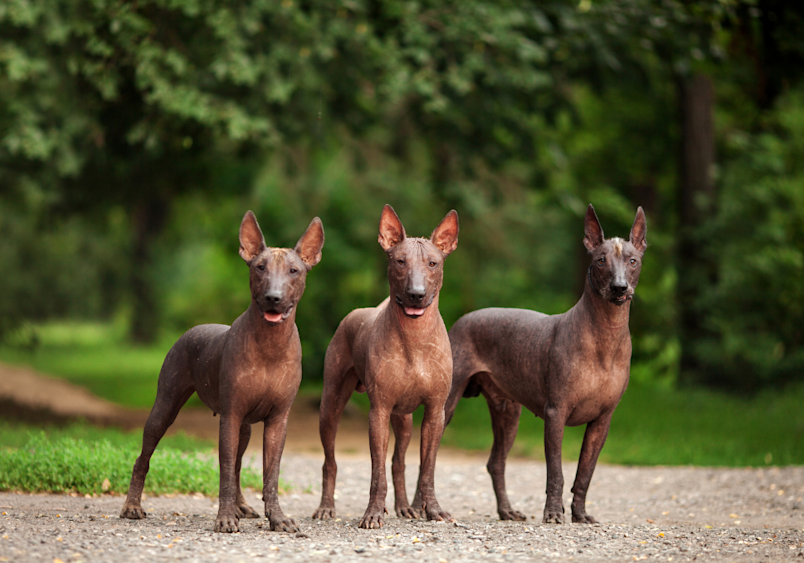
When you think about Mexican dog breeds, the first one who comes to mind is probably the Chihuahua, a teeny nugget of a dog who will always tell you what they’re thinking (these guys should have their own talk shows).
But despite their popularity, they’re not Mexico’s national dog. That honor goes to the Xoloitzcuintli (say “show-low” for short), worshiped by the Aztecs as the guides to the underworld. In fact, Aztec and Mayan civilizations believed dogs traveled between worlds, acting as chaperones and protectors for their humans.
Dogs have been domesticated in Mexico for at least 3,000 years, and while certain dogs in Mexico (we’re looking at you, Chihuahuas and Xolos) may be the most well-known, there are other pups who are just as deserving of your attention.
The Chihuahua from Mexico
Weighing in at 6 pounds (give or take a few), these adorable, talkative nuggets have a reputation for speaking their mind, but ironically, they’re thought to have evolved from a tiny mute dog breed kept by the Techichi people in the 9th century. So, if you’re wondering, “Are Chihuahuas Mexican?”, the answer is yes—though there are rumors that they originated in Europe or even China.
While you may occasionally find a more chill Chihuahua, most are playful and sassy, and they thrive on mental stimulation. Consider fun puzzles and toys, and some training with positive reinforcement can also go a long way for calming these talkative cuties, who are ideal for adults or families with older children.
Chihuahuas catapulted to popularity after a series of (we’ll say it—tacky) Taco Bell commercials in the 1990s. While demand for the breed skyrocketed, many owners didn’t keep their “fad” pet, and it led to a shelter crisis with thousands of unwanted Chihuahuas in need.
Paris Hilton notably had several Chihuahuas in the 2000s, and when her 23-year-old Chi passed away in 2023, she penned a heartfelt tribute on Instagram.
Chihuahuas are playful, fun, and delightful balls of energy, but make sure to look into dog insurance, as they’re prone to issues common to many small dog breeds.
The Famous Mexican Xoloitzcuintli
Recognized as Mexico’s national dog and once worshiped by the Aztecs, the Xoloitzcuintli (say “show-low-eetz-kweent-lee”) may be the oldest dog in the Americas—their lineage goes back at least 3,000 years old. Ancient civilizations believed they protected people from evil spirits, and they were also thought to be guides to the underworld.
These watchful, loyal pups are sensitive creatures who can be reserved at first, so they need a family who’s all-in on them—once they trust you, you’ve got a best friend forever. (Note that they don’t do well with tiny animals, like rabbits, in the house.)
While some Xolos have a short coat of fur, most are naked (with perhaps a bit of fuzz atop their head). These naked cuties need a skin care routine, not to mention serious sunscreen. They’re prone to acne, and they also need a good moisturizer (they’d have a field day at a doggie Sephora).
These pups might look familiar if you’ve spent a lot of time in museums. They’re the serious dogs adorning ancient pre-Columbian pottery, but you might also recognize them from the work of artists Diego Rivera and Frida Kahlo, who kept them as pets and portrayed them in their paintings. More recently, in the Pixar film Coco, Dante the Xolo was a loyal, goofy, and affable companion to a little boy; he guides him through the Land of the Dead to meet his ancestors.

The Chamuco
These muscular little pitties are unfortunately Mexico’s most misunderstood breed. And heartbreakingly, there aren’t many around today—at least not as everyday pets.
Thought to be bred for the first time in the 1970s, Chamucos are strong, short-legged pit bulls who can weigh up to 50 pounds. But these short stacks definitely got the short end of the stick: Even their name means “devil” in Spanish, suggesting they don’t get the love they deserve.
Like many bully breeds, who can be loving companions, the Chamuco’s loyalty is often taken advantage of, and many are bred to fight. Their true nature is one of allegiance and kindness, and they make great family dogs when well-socialized and given the chance to be their authentic self.
Pit bulls have a predisposition to hip dysplasia, and Mexican pit bulls can be prone to skin disorders and thyroid problems, so if you do rescue one of these sweet dogs, don't forget to check in with Embrace Pet Insurance.
The Chinese Crested
The Chinese Crested's name is a bit misleading, since it was thought they originated from African dogs, which Chinese breeders then bred tinier. They were found in Mexico, however, in the 1500s!
These dogs come in two varieties: the hairless and the Powderpuff. The latter is a low shedder but still needs frequent brushing, while hairless Chinese Cresteds have skin issues similar to Xolos. They’re also prone to acne and need to wear sunscreen and moisturizer like the little stars they are.
If you’re looking for a kind, gentle best friend who wants to go shopping for doggie sweaters—and sticks to you like glue—look no further than these little guys. Keep in mind: While they’re not quite as yappy as their Chihuahua cousins, they still know how to start a conversation, and they’re not the easiest dogs to housetrain. So, early training can go a long way for these adorable mythical creatures (okay, they only sometimes look like magical mini ponies). Like many small breeds, they can have conditions like a collapsed trachea as well as dental problems, hip dysplasia, and other issues that make insurance a smart bet.
The Calupoh
The Calupoh looks like a big, fuzzy black wolf—only he’s a hybrid wolf-dog. In pre-Columbian times, dogs and wolves co-existed, so it was only natural that the two interacted and bred.
Interestingly, ancient civilizations may have wanted these two animals to become one, as both had significant spiritual meanings. In Mexican culture, the dog was considered a high-fertility animal who brought good fortune (and good crops), and the wolf represented power. A hybrid signaled good luck—financially, militarily, and spiritually.
These majestic dogs are quick and athletic, and they can be close to 3 feet tall. They are also elegant with eyes that are often a striking shade of yellow. They do best in homes with lots of space, as they can weigh up to 120 pounds. They benefit from lots of exercise, so if you’re looking for a hiking buddy, you’ve just found a perfect, loyal companion.
All the Dogs in Mexico
Mexican dogs play an important role in their country’s cultural and artistic history, and it’s important to celebrate these honored hounds.
The Day of the Dead, or Día de los Muertos, a Mexican holiday that honors those who have passed, takes place on November 1 and 2 each year. People create altars to honor family members who have passed—and for many people, those family members include pets. Altars can be arranged with photos, candles, and even a beloved pet’s favorite treat or toy.
Día de los Muertos was inspired by an Aztec ritual, and it’s lovely to see a culture where canines have been valued and treasured for generations. After all, they’re dogs—they deserve all the respect and love in the world.